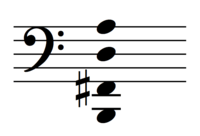Sonata for Solo Cello (Kodály)
The Hungarian composer Zoltán Kodály wrote his Sonata in B minor for solo cello, Op. 8, in 1915. It was first performed in 1918 and published in 1921.

It is among the most significant works for solo cello written since Johann Sebastian Bach's Cello Suites. It contains influences of Debussy and Bartók, as well as the inflections and nuances of Hungarian folk music.[2]
Premiere
The sonata was written in 1915 but its premiere was delayed due to World War I.[2] It was premiered by Jenő Kerpely (1885–1954; sometimes seen as Eugène de Kerpely) in Budapest on 7 May 1918.[3] Kerpely was the cellist of the Waldbauer-Kerpely Quartet, which had premiered the first four string quartets by Bartók.[4] It was published by Universal Edition in Vienna in 1921.[3]
Recognition
Kodály himself predicted that "in 25 years no cellist will be accepted who has not played it". Indeed, less than 40 years later, in 1956, the sonata was a set piece for the Casals Competition in Mexico City.[5] But in the meantime it had to earn its recognition. George Neikrug's playing of it at his debut at the New York Town Hall in 1947 was the first American performance of the work for many years.[6]
Structure
The solo sonata is in three movements:
- I. Allegro maestoso ma appassionato
- II. Adagio con gran espressione
- III. Allegro molto vivace.
Recordings
The Sonata for solo cello has been recorded many times, by cellists such as Erling Blöndal Bengtsson, Natalie Clein, Rohan de Saram, Antony Cooke, Gisela Depkat, Pierre Fournier, Alban Gerhardt, Matt Haimovitz, Frans Helmerson, Yo-Yo Ma, André Navarra, George Neikrug, Zara Nelsova, Truls Mørk, David Pereira, János Starker, Yuli Turovsky, Alisa Weilerstein, Colin Carr, and Pieter Wispelwey.
János Starker first played it for Kodály at the age of 15, in 1939, then again in 1967 shortly before the composer's death. Kodály told Starker: "If you correct the ritard in the third movement, it will be the Bible performance".[5] Starker recorded it four times (1948, 1950, 1956 and 1970), the 1948 78-rpm recording winning a Grand Prix du Disque.[5]
Popular Culture
The piece is mentioned in Samuel R. Delany's The Einstein Intersection. Lobey learns of his ability to hear the music that runs through others' minds when he plays the melodies that he hears out of the dragon herder Spider's head: "You got it out of my head? ... You couldn't have heard it before unless I was going around humming. And I can't hum a crescendo of triple stops" (59).
References
- "Zoltán Kodály's Sonata for Unaccompanied Cello, Op. 8: one cellist's path to performance" (PDF). Celeste Power. Retrieved June 5, 2018.
- Classical Archives
- IMSLP
- allthingsstrings
- 6moons.com
- cdbaby